SN/T 1741-2006
基本信息
标准号: SN/T 1741-2006
中文名称:进出口食品中甲草胺残留量的检测方法气相色谱串联质谱法
标准类别:商检行业标准(SN)
英文名称:Determination of alachlor residues in foods for import and export-Gas chromatography mass spectrometry method
标准状态:已作废
发布日期:2006-01-26
实施日期:2006-08-16
作废日期:2014-12-22
下载格式:pdf zip
相关标签: 进出口 食品 残留量 检测 方法 相色谱 串联 质谱法

标准分类号
标准ICS号: 农业>>65.100杀虫剂和其他农用化工产品
中标分类号:农业、林业>>植物保护>>B17农药管理与使用方法
出版信息
页数:16页
标准价格:21.0
相关单位信息
起草单位:国家认证认可监督管理委员会
标准简介
标准图片预览
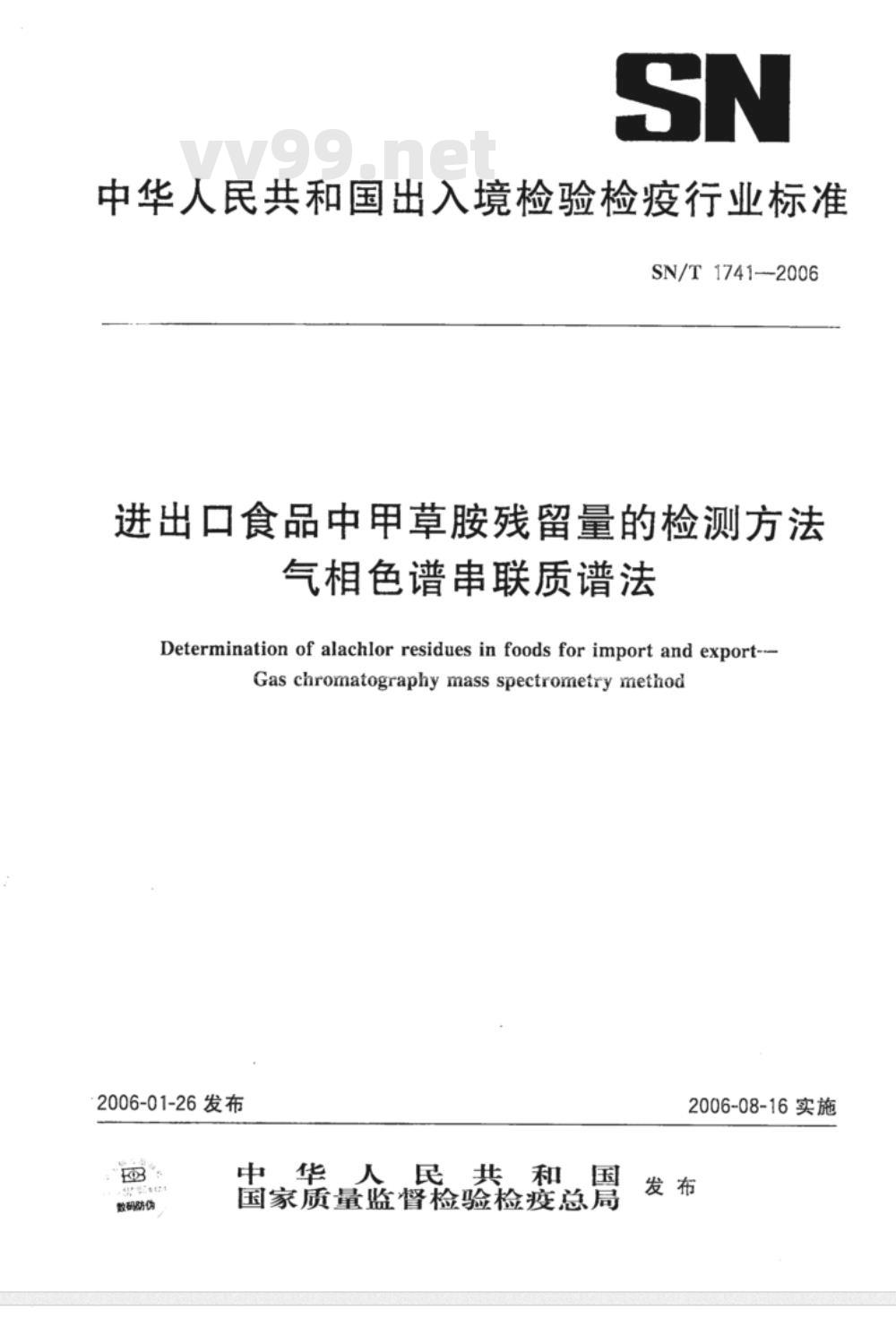
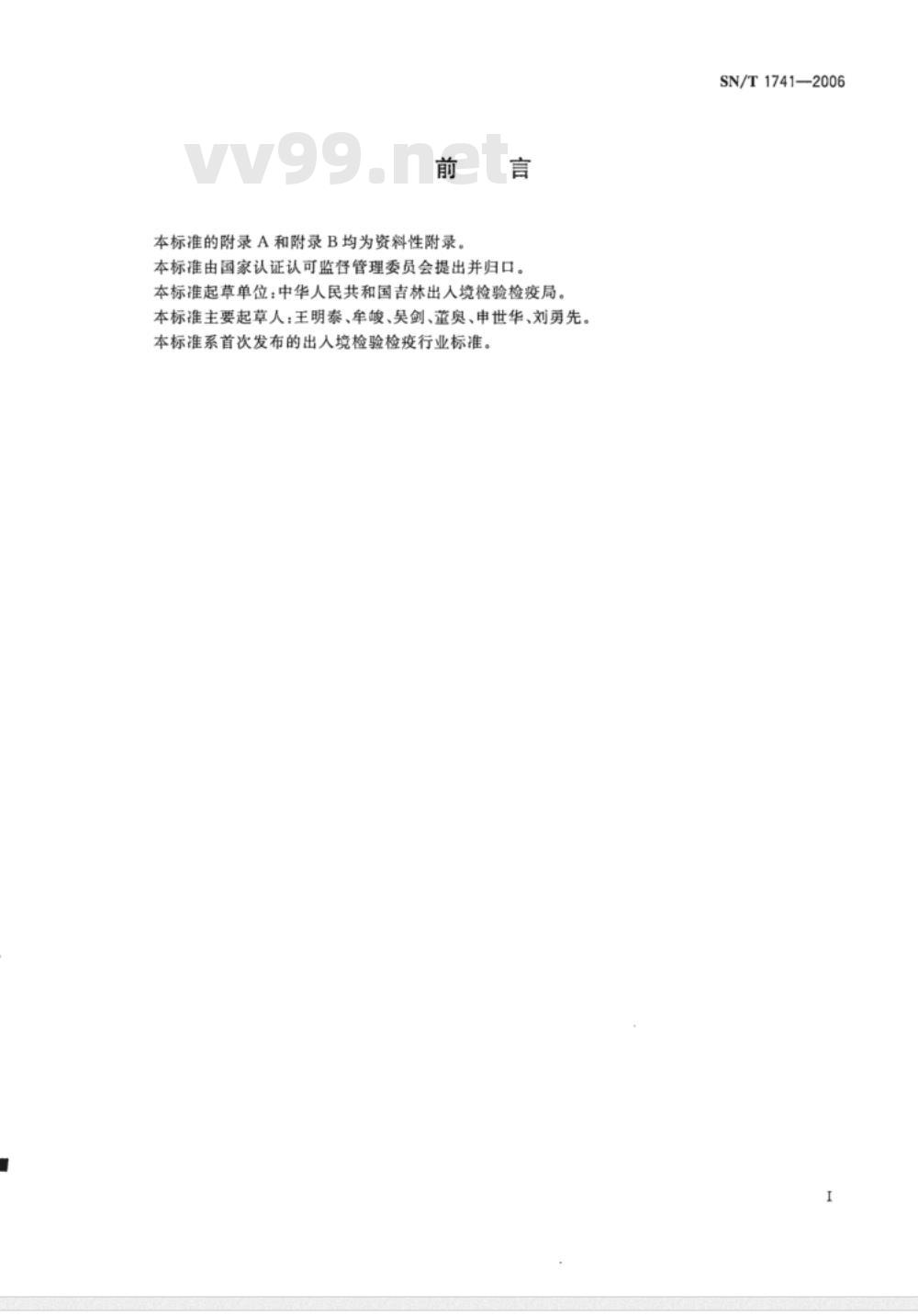
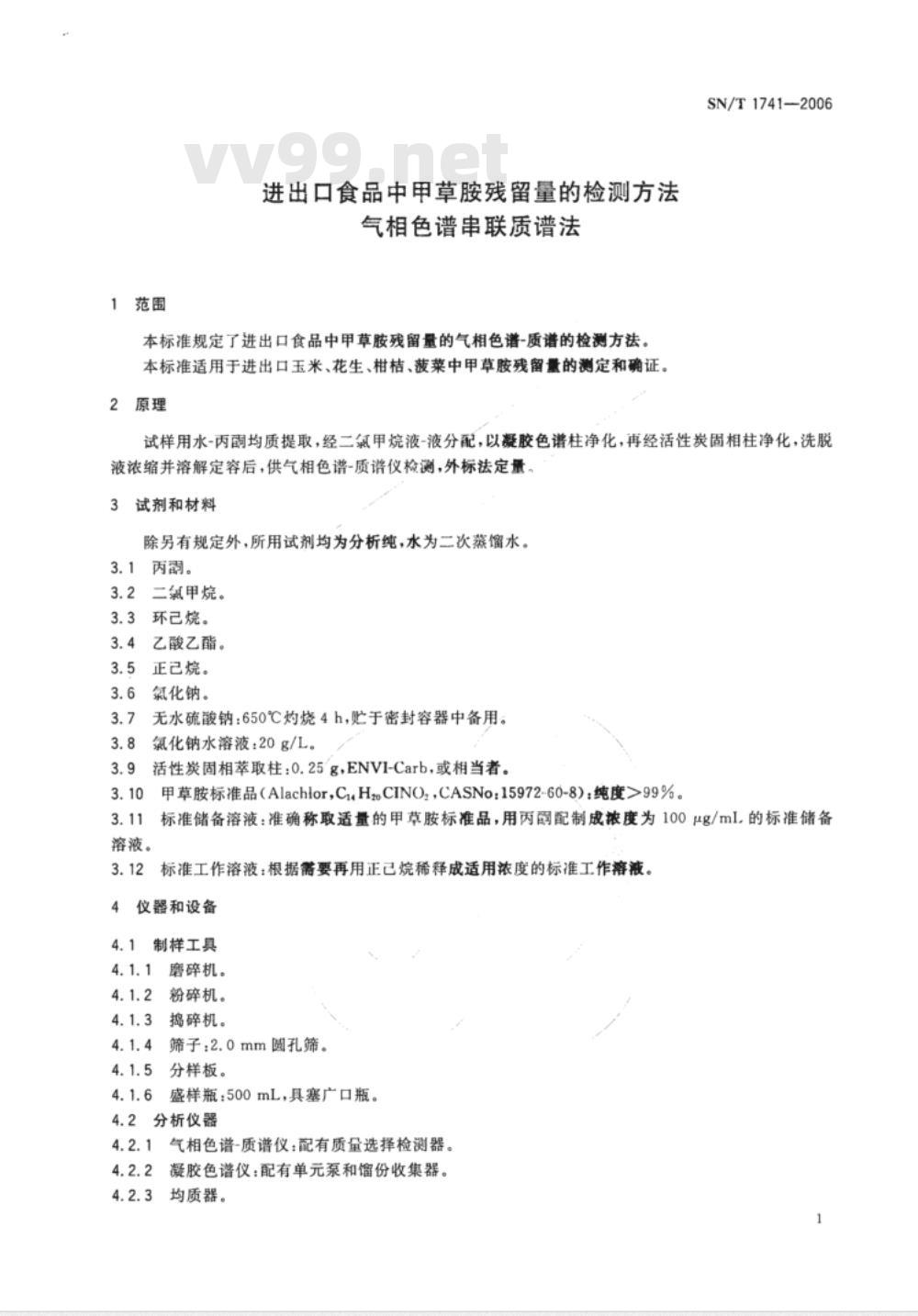
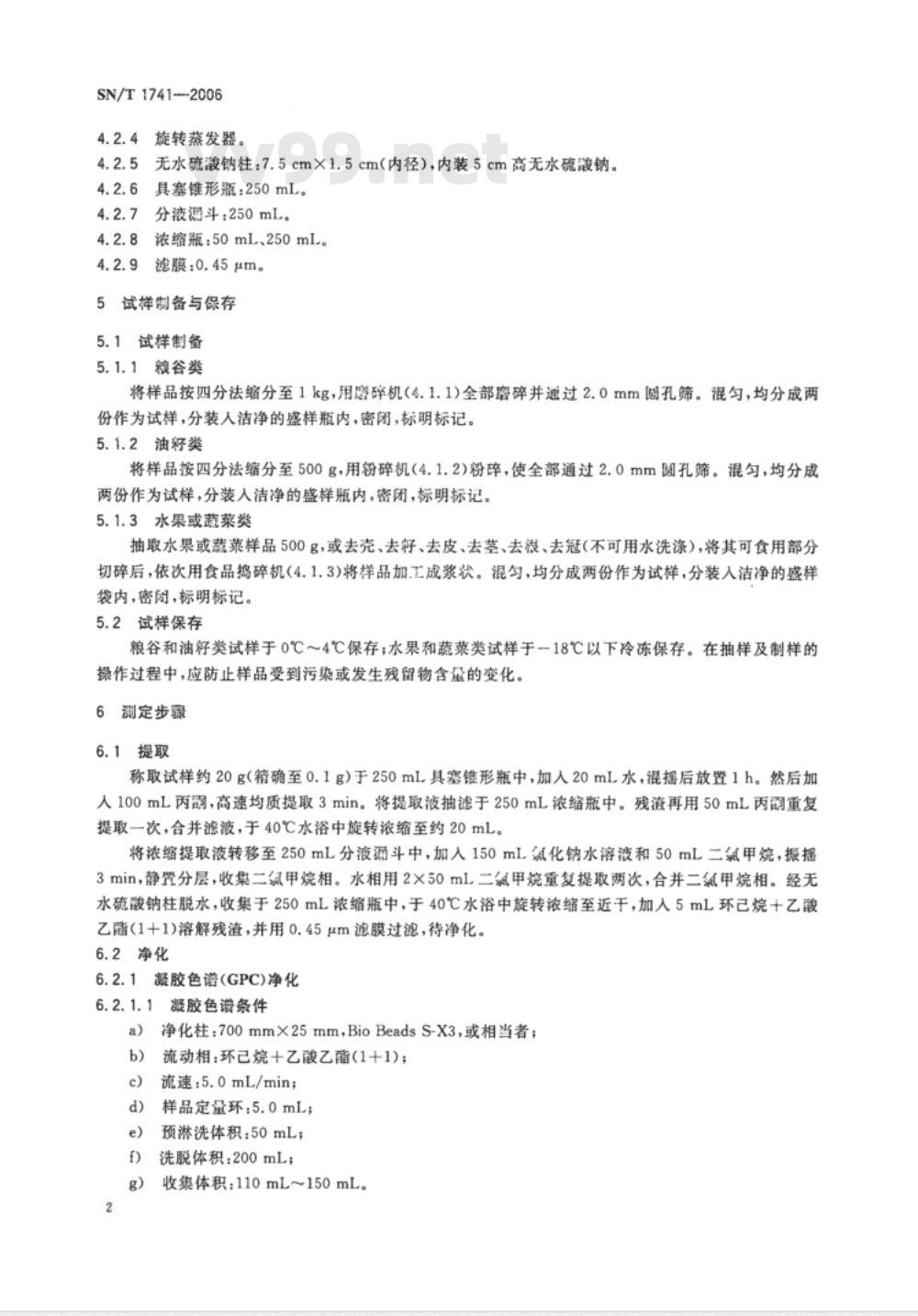
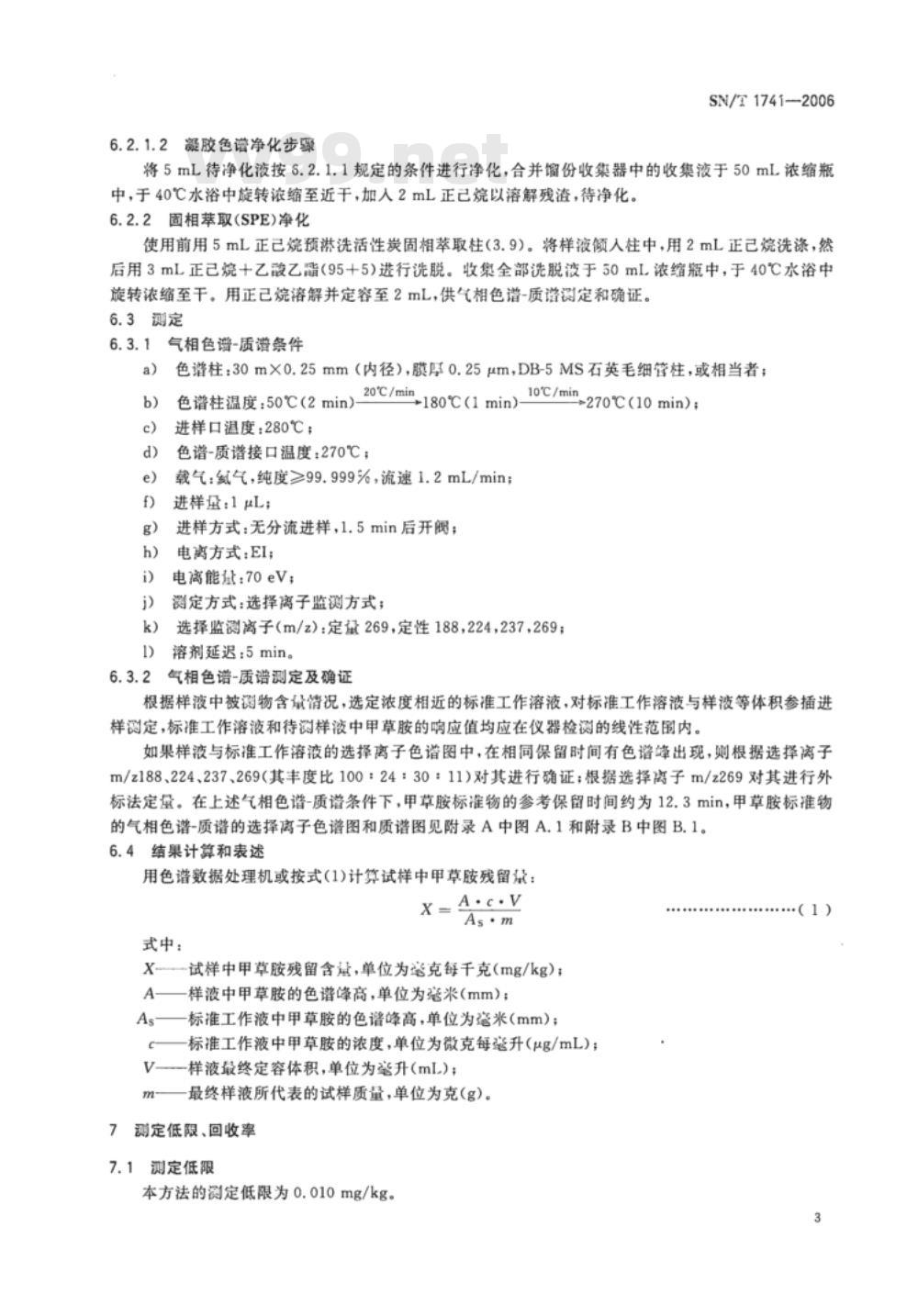
标准内容
中华人民共和国出入境检验检疫行业标准SN/T1741--2006
进出口食品中甲草胺残留量的检测方法气相色谱串联质谱法
Determination of alachlor residues in foods for import and export-Gas chromatography mass spectrometry method2006-01-26发布
数码防伪
中华人民共和国
国家质量监督检验检疫总局
2006-08-16实施
本标准的附录A和附录B均为资料性附录。本标准由国家认证认可监督管理委员会提出并归口。本标准起草单位:中华人民共和国吉林出入境检验检疫局,本标准主要起草人:王明泰、牟峻、吴剑、董奥、申世华、刘勇先。本标准系首次发布的出人境检验检疫行业标准。SN/T1741—2006
进出口食品中甲草胺残留量的检测方法气相色谱串联质谱法
本标准规定了进出口食品中甲草胺残留量的气相色谱-质谱的检测方法。本标准适用于进出口玉米、花生、柑桔、菠菜中甲草胺残留量的测定和确证。2原理
SN/T17412006
试样用水-丙酮均质提取,经二氯甲烷液-液分配,以凝胶色谱柱净化,再经活性炭固相柱净化,洗脱液浓缩并溶解定容后,供气相色谱-质谱仪检测,外标法定量,3
试剂和材料
除另有规定外,所用试剂均为分析纯,水为二次蒸馏水。3.1丙霸。
3.2二氯甲烷。
3.3环已烷。
乙酸乙酯。
3.5正已烷。
氯化钠。
无水硫酸钠:650℃灼烧4h,贮于密封容器中备用。氯化钠水溶液:20g/L。
活性炭固相萃取柱:0.25g,ENVI-Carb,或相当者。甲草胺标准品(Alachior,CHzCINO:,CASNo:15972-60-8):纯度>99%。标准储备溶液:准确称取适量的甲草胺标准品,用丙酮配制成浓度为100μg/ml的标准储备溶液。
标准工作溶液:根据需要再用正已烷稀释成适用浓度的标准工作溶液。4
仪器和设备
制样工具
磨碎机。
粉碎机。
捣碎机。
筛子:2.0mm圆孔筛。
分样板。
盛样瓶:500mL,具塞广口瓶。
分析仪器
气相色谱-质谱仪:配有质量选择检测器。凝胶色谱仪:配有单元泵和馏份收集器。均质器。
SN/T1741--2006
4.2.4旋转蒸发器。
4.2.5无水硫酸钠柱:7.5cm×1.5cm(内径),内装5cm高无水硫酸钠。4.2.6具塞锥形瓶:250mL。
4.2.7分液斗:250mL。
4.2.8浓缩瓶:50mL、250mL。
4.2.9滤膜:0.45μm。
5试样制备与保存
5.1试样制备
5.1.1粮谷类
将样品按四分法缩分至1kg,用磨碎机(4.1.1)全部磨碎并通过2.0mm圆孔筛。混匀,均分成两份作为试样,分装人洁净的盛样瓶内,密闭,标明标记。5.1.2油籽类
将样品按四分法缩分至500g,用粉碎机(4.1.2)粉碎,使全部通过2.0mm圆孔筛。混匀,均分成两份作为试样,分装人洁净的盛样瓶内,密闭,标明标记。5.1.3水果或蔬菜类
抽取水果或截菜样品500g,或去壳、去籽、去皮、去茎、去根、去冠(不可用水洗涤),将其可食用部分切碎后,依次用食品捣碎机(4.1.3)将样品加.工成浆状。混匀,均分成两份作为试样,分装入洁净的盛样袋内,密闭,标明标记。
5.2试样保存
粮谷和油籽类试样于0℃~4℃保存;水果和蔬菜类试样于一18℃以下冷冻保存。在抽样及制样的操作过程中,应防止样品受到污染或发生残留物含量的变化。6测定步骤
6.1提取
称取试样约20g(精确至0.1g)于250mL具塞锥形瓶中,加人20mL水,混摇后放置1h。然后加入100mL丙酮,高速均质提取3min。将提取液抽滤于250mL浓缩瓶中。残渣再用50mL丙酮重复提取一次,合并滤液,于40℃水浴中旋转浓缩至约20mL。将浓缩提取液转移至250mL分液漏斗中,加人150mL氛化钠水溶液和50mL二氯甲烷,振摇3min,静置分层,收集二氟甲烷相。水相用2×50ml二氯甲烷重复提取两次,合并二氛甲烷相。经无水硫酸钠柱脱水,收集于250mL浓缩瓶中,于40℃水浴中旋转浓缩至近干,加入5mL环己烷十乙酸乙酯(1十1)溶解残渣,并用0.45μm滤膜过滤,待净化。6.2净化
6.2.1凝胶色谱(GPC)净化
凝胶色谱条件
净化柱:700mm×25mm,BioBeadsS-X3,或相当者;b)
流动相:环已烷十乙酸乙酯(1十1);流速:5.0mL/min;
样品定量环:5.0mL;
预淋洗体积:50mL;
洗脱体积:200mL;
收集体积:110mL~150mL。
6.2.1.2凝胶色谱净化步骤
SN/T1741-2006
将5mL待净化液按6.2.1.1规定的条件进行净化,合并馏份收集器中的收集液于50mL浓缩瓶中,于40℃水浴中旋转浓缩至近干,加人2mL正己烷以溶解残渣,待净化。6.2.2固相萃取(SPE)净化
使用前用5mL正已烷预淋洗活性炭固相萃取柱(3.9)。将样液倾入柱中,用2mL正已烷洗涤,然后用3mL正已烷十乙酸乙嘴(95十5)进行洗脱。收集全部洗脱液于50mL浓缩瓶中,于40℃水浴中旋转浓缩至干。用正已烷溶解并定容至2mL,供气相色谱-质谱测定和确证。6.3测定
6.3.1气相色谱-质谱条件
色谱柱:30mX×0.25mm(内径),膜厚0.25μm,DB-5MS石英毛细管柱,或相当者;10℃/ming270℃(10min);
20℃/min
色谱柱温度:50℃(2min)
+180℃(1min)
进样口温度:280℃;
色谱-质谱接口温度:270℃;
载气:氢气,纯度≥99.999%,流速1.2mL/min;进样蛋:1μL;
进样方式:无分流进样,1.5min后开阀;电离方式:EI;
电离能盘:70eV;
测定方式:选择离子监测方式;k)
选择监测离子(m/z):定量269,定性188,224,237,269;1)溶剂延迟:5min。
2气相色谱-质谱测定及确证
根据样液中被测物含量情况,选定浓度相近的标准工作溶液,对标准工作溶液与样液等体积参插进样测定,标准工作溶液和待测样液中甲草胺的响应值均应在仪器检测的线性范围内。如果样液与标准工作溶液的选择离子色谐图中,在相同保留时间有色谱峰出现,则根据选择离子m/z188、224、237、269(其丰度比100:24:30:11)对其进行确证;根据选择离子m/z269对其进行外标法定量。在上述气相色谱-质谱条件下,甲草胺标准物的参考保留时间约为12.3min,甲草胺标准物的气相色谱-质谱的选择离子色谱图和质谱图见附录A中图A.1和附录B中图B.1。6.4结果计算和表述
用色谱数据处理机或按式(1)计算试样中甲草胺残留景:A.c.V
式中:
X-—-试样中甲草胺残留含,单位为毫克每千克(mg/kg);A一样液中甲草胺的色谱峰高,单位为毫米(mm);As
标准工作液中甲草胺的色谱峰高,单位为意米(mm);c
标准工作液中甲草胺的浓度,单位为微克每毫升(μg/mL);V—样液最终定容体积,单位为毫升(mL);m-
最终样液所代表的试样质量,单位为克(g)。7测定低限、回收率
7.1测定低限
本方法的测定低限为0.010mg/kg。.(1)
SN/T1741—2006
7.2回收率
7.2.1玉米中甲草胺的添加浓度及其回收率实验数据:在0.010mg/kg~0.200mg/kg时,回收率为89.2%~91.3%。7.2.2花生中甲草胺的添加浓度及其回收率实验数据:在0.010mg/kg~0.200mg/kg时,回收率为87.5%~97.6%。7.2.3柑桔中甲草胺的添加浓度及其回收率实验数据:在0.010mg/kg~0.200mg/kg时,回收率为88.5%~94.0%。7.2.4菠菜中甲草胺的添加浓度及其回收率实验数据:在0.010mg/kg~0.200mg/kg时,回收率为88.8%~95.8%。18.000
14 000
12 000
10 000
220 000
120 000
100 000
附录A
(资料性附录)
甲草胺标准物的气相色谱-质谱选择离子色谱图12.29/alachlor
SN/T17412006
hopyleppgypygpappy
pmt/min
10. 00 11. 00 12. 00 13. 00 14. 0015. 00 16. 00 17.0018.0019.00
甲草胺标准物的气相色谱-质谱选择离子色谱图附录B
(资料性附录)
甲草胺标准物的气相色谱-质谱色谱图160
25:4139/1534
18011851E213.m
甲草胺标准物的气相色谱-质谱图240
300m/zvv99.net
SN/T1741—2006
Foreword
AnnexAofthisstandardisan informativeannex.This standard was proposed by and is under the charge of the Certification and Accreditation Admin-istrationofthePeople'sRepublicofChina.This standard was drafted by the Jilin Entry-Exit Inspection and Quarantine Bureau of the People'sRepublic of China.
This main drafter of this standard is Wang Mingtai, Mu Jun,Wu Jian,Dong Ao,Shen Shihua,LiuYongxian.
This standard is aprofessional standard promulgated forthe first time.NoteThis English version,a translation from the Chinese text,is solely for guidance.6
SN/T17412006
Determinationofalachlorresiduesinfoodsforimportandexport-Gaschromatographymassspectrometry method
This standard specifies the determination of alachlor residues by gas chromatography-mass spectrometryinfoodsforimportandexport.This standard is applicable to the determination and confirmation of residue content of alachlor inmaize,peanut,orangeand spinach for import and export.2
Principle
Thetest sampleareextracted withwater-acetone.The extract ispartitioned with dichloromethane.Cleaned up by passing through a on GPC and ENVI-Carb column.The elutes solution is evaporatedand made up to adefinite volume.Determination and confirmation is madeby GC-MS,using externalstandard method
Reagents andmaterials
Unless otherwise specified,all the reagents used should be analytically pure,\water\ is distilled wa-ter.
Dichloromethane.
Cyclohexane.
Ethylacetate.
n-Hexane.
Sodium chloride.
Anhydrous sodium sulfate:lgnite at650℃ for 4h,and keep ina tightly closed container.Sodiumchlorideaqueoussolution:20g/L.7
SN/T1741—2006
ActivecarbonSPEtubes:0.25g,ENVi-Carb,orequivalent.Alachlorstandard(C4HzoCINO2,CAS:15972-60-8):Purity≥99%Standard stock solution:Accurately weigh an adequate amount of alachlor standard and dis-solve in a small volume of acetone. Dilute with acetone to form a standard stock solution of 100 μg/mL in concentration.
Standard working solution: Then dilute the standard stock solution with acetone to the re-quired concentrationas the standardworking solution.4
Apparatusandequipment
Samplingtools
Pulverizer.
High speed blender.
Sieve:2.0 mm round-hole sieve.Plate for quartering
Sample container:5oomL,Wide-mouth bottle,with ground stopper.Analyzing instrument
Gas chromatographequippedwithmass selectivedetector (MsD).Gelpermeation chromatographequipped with isocraticpumpand fraction collector.Homogenizer.
Rotaryvacuum evaporator.
Column of anhydrous sodium sulfate:7.5 cm×1.5 cm(i.d.),packed with 5 cm height of an-hydroussodiumsulfate.
Conicalflask:250mL,withstopper.Separatorfunnel:250mL.
4.2.8Concentratebottle:50mL,250mL.9Membranefilter:0.45μm.
5Preparationandstorageoftestsample5.1Preparationof testsample
Cereals
SN/T1741—2006
Reduce by quartering to ca 1 kg. Grind with a grinder (4. 1. 1) to let all pass through a 2. 0 mm roundhole sieve. Mix thoroughly and divide into two equal portions,place in clean sample containers as thetest samples,seal and label.2Oilseeds
Reduce by quartering to ca 500 g,pulverize with a pulverizer (4.1.2) to let all pass through a 2. 0 mmround-hole sieve. Mix thoroughly and divide into two equal portions as the test samples,place incleansamplecontainers,sealandlabel.5.1.3Fruits and vegetables
The combined primary sample is reduced to ca 50o g,which has been removed sheil,seed,peel,stem,root,coronal (do not wash by water),then cut up the edible portions are blended and homoge-nized thoroughly in a high speed blender (4. 1.3),and then divided into two equal portions. Eachportion is placed in a clean container as the test sample,which is then sealed and labeled.5.2
Storageoftestsample
The test samples of cereals and oil seeds should be stored below o'c~4c,the test samples of fruitsand vegetables should be stored below-18.fnthe courseof samipling and samplepreparation,precautions must be taken to avoid contamination orany factors that may cause the change of resi-duecontent.
Procedure
Extraction
Weigh ca 20 g (accurate to 0.1 g) of the test sample into a 250 mL conical flask with stopper,add 20mL of water and let stand for 1 h.Add 100 mL of acetone,extractfor3min on a high speed homoge-nizer.Filter theextract intoa250 mLconcentratebottle.Extractthe residuewith50 mLof acetoneonce more,filter and combine the washings in the same concentrate bottle,evaporate to 20 mL in arotaryevaporatorwithabathtemperaturebelow4o.9
小提示:此标准内容仅展示完整标准里的部分截取内容,若需要完整标准请到上方自行免费下载完整标准文档。
进出口食品中甲草胺残留量的检测方法气相色谱串联质谱法
Determination of alachlor residues in foods for import and export-Gas chromatography mass spectrometry method2006-01-26发布
数码防伪
中华人民共和国
国家质量监督检验检疫总局
2006-08-16实施
本标准的附录A和附录B均为资料性附录。本标准由国家认证认可监督管理委员会提出并归口。本标准起草单位:中华人民共和国吉林出入境检验检疫局,本标准主要起草人:王明泰、牟峻、吴剑、董奥、申世华、刘勇先。本标准系首次发布的出人境检验检疫行业标准。SN/T1741—2006
进出口食品中甲草胺残留量的检测方法气相色谱串联质谱法
本标准规定了进出口食品中甲草胺残留量的气相色谱-质谱的检测方法。本标准适用于进出口玉米、花生、柑桔、菠菜中甲草胺残留量的测定和确证。2原理
SN/T17412006
试样用水-丙酮均质提取,经二氯甲烷液-液分配,以凝胶色谱柱净化,再经活性炭固相柱净化,洗脱液浓缩并溶解定容后,供气相色谱-质谱仪检测,外标法定量,3
试剂和材料
除另有规定外,所用试剂均为分析纯,水为二次蒸馏水。3.1丙霸。
3.2二氯甲烷。
3.3环已烷。
乙酸乙酯。
3.5正已烷。
氯化钠。
无水硫酸钠:650℃灼烧4h,贮于密封容器中备用。氯化钠水溶液:20g/L。
活性炭固相萃取柱:0.25g,ENVI-Carb,或相当者。甲草胺标准品(Alachior,CHzCINO:,CASNo:15972-60-8):纯度>99%。标准储备溶液:准确称取适量的甲草胺标准品,用丙酮配制成浓度为100μg/ml的标准储备溶液。
标准工作溶液:根据需要再用正已烷稀释成适用浓度的标准工作溶液。4
仪器和设备
制样工具
磨碎机。
粉碎机。
捣碎机。
筛子:2.0mm圆孔筛。
分样板。
盛样瓶:500mL,具塞广口瓶。
分析仪器
气相色谱-质谱仪:配有质量选择检测器。凝胶色谱仪:配有单元泵和馏份收集器。均质器。
SN/T1741--2006
4.2.4旋转蒸发器。
4.2.5无水硫酸钠柱:7.5cm×1.5cm(内径),内装5cm高无水硫酸钠。4.2.6具塞锥形瓶:250mL。
4.2.7分液斗:250mL。
4.2.8浓缩瓶:50mL、250mL。
4.2.9滤膜:0.45μm。
5试样制备与保存
5.1试样制备
5.1.1粮谷类
将样品按四分法缩分至1kg,用磨碎机(4.1.1)全部磨碎并通过2.0mm圆孔筛。混匀,均分成两份作为试样,分装人洁净的盛样瓶内,密闭,标明标记。5.1.2油籽类
将样品按四分法缩分至500g,用粉碎机(4.1.2)粉碎,使全部通过2.0mm圆孔筛。混匀,均分成两份作为试样,分装人洁净的盛样瓶内,密闭,标明标记。5.1.3水果或蔬菜类
抽取水果或截菜样品500g,或去壳、去籽、去皮、去茎、去根、去冠(不可用水洗涤),将其可食用部分切碎后,依次用食品捣碎机(4.1.3)将样品加.工成浆状。混匀,均分成两份作为试样,分装入洁净的盛样袋内,密闭,标明标记。
5.2试样保存
粮谷和油籽类试样于0℃~4℃保存;水果和蔬菜类试样于一18℃以下冷冻保存。在抽样及制样的操作过程中,应防止样品受到污染或发生残留物含量的变化。6测定步骤
6.1提取
称取试样约20g(精确至0.1g)于250mL具塞锥形瓶中,加人20mL水,混摇后放置1h。然后加入100mL丙酮,高速均质提取3min。将提取液抽滤于250mL浓缩瓶中。残渣再用50mL丙酮重复提取一次,合并滤液,于40℃水浴中旋转浓缩至约20mL。将浓缩提取液转移至250mL分液漏斗中,加人150mL氛化钠水溶液和50mL二氯甲烷,振摇3min,静置分层,收集二氟甲烷相。水相用2×50ml二氯甲烷重复提取两次,合并二氛甲烷相。经无水硫酸钠柱脱水,收集于250mL浓缩瓶中,于40℃水浴中旋转浓缩至近干,加入5mL环己烷十乙酸乙酯(1十1)溶解残渣,并用0.45μm滤膜过滤,待净化。6.2净化
6.2.1凝胶色谱(GPC)净化
凝胶色谱条件
净化柱:700mm×25mm,BioBeadsS-X3,或相当者;b)
流动相:环已烷十乙酸乙酯(1十1);流速:5.0mL/min;
样品定量环:5.0mL;
预淋洗体积:50mL;
洗脱体积:200mL;
收集体积:110mL~150mL。
6.2.1.2凝胶色谱净化步骤
SN/T1741-2006
将5mL待净化液按6.2.1.1规定的条件进行净化,合并馏份收集器中的收集液于50mL浓缩瓶中,于40℃水浴中旋转浓缩至近干,加人2mL正己烷以溶解残渣,待净化。6.2.2固相萃取(SPE)净化
使用前用5mL正已烷预淋洗活性炭固相萃取柱(3.9)。将样液倾入柱中,用2mL正已烷洗涤,然后用3mL正已烷十乙酸乙嘴(95十5)进行洗脱。收集全部洗脱液于50mL浓缩瓶中,于40℃水浴中旋转浓缩至干。用正已烷溶解并定容至2mL,供气相色谱-质谱测定和确证。6.3测定
6.3.1气相色谱-质谱条件
色谱柱:30mX×0.25mm(内径),膜厚0.25μm,DB-5MS石英毛细管柱,或相当者;10℃/ming270℃(10min);
20℃/min
色谱柱温度:50℃(2min)
+180℃(1min)
进样口温度:280℃;
色谱-质谱接口温度:270℃;
载气:氢气,纯度≥99.999%,流速1.2mL/min;进样蛋:1μL;
进样方式:无分流进样,1.5min后开阀;电离方式:EI;
电离能盘:70eV;
测定方式:选择离子监测方式;k)
选择监测离子(m/z):定量269,定性188,224,237,269;1)溶剂延迟:5min。
2气相色谱-质谱测定及确证
根据样液中被测物含量情况,选定浓度相近的标准工作溶液,对标准工作溶液与样液等体积参插进样测定,标准工作溶液和待测样液中甲草胺的响应值均应在仪器检测的线性范围内。如果样液与标准工作溶液的选择离子色谐图中,在相同保留时间有色谱峰出现,则根据选择离子m/z188、224、237、269(其丰度比100:24:30:11)对其进行确证;根据选择离子m/z269对其进行外标法定量。在上述气相色谱-质谱条件下,甲草胺标准物的参考保留时间约为12.3min,甲草胺标准物的气相色谱-质谱的选择离子色谱图和质谱图见附录A中图A.1和附录B中图B.1。6.4结果计算和表述
用色谱数据处理机或按式(1)计算试样中甲草胺残留景:A.c.V
式中:
X-—-试样中甲草胺残留含,单位为毫克每千克(mg/kg);A一样液中甲草胺的色谱峰高,单位为毫米(mm);As
标准工作液中甲草胺的色谱峰高,单位为意米(mm);c
标准工作液中甲草胺的浓度,单位为微克每毫升(μg/mL);V—样液最终定容体积,单位为毫升(mL);m-
最终样液所代表的试样质量,单位为克(g)。7测定低限、回收率
7.1测定低限
本方法的测定低限为0.010mg/kg。.(1)
SN/T1741—2006
7.2回收率
7.2.1玉米中甲草胺的添加浓度及其回收率实验数据:在0.010mg/kg~0.200mg/kg时,回收率为89.2%~91.3%。7.2.2花生中甲草胺的添加浓度及其回收率实验数据:在0.010mg/kg~0.200mg/kg时,回收率为87.5%~97.6%。7.2.3柑桔中甲草胺的添加浓度及其回收率实验数据:在0.010mg/kg~0.200mg/kg时,回收率为88.5%~94.0%。7.2.4菠菜中甲草胺的添加浓度及其回收率实验数据:在0.010mg/kg~0.200mg/kg时,回收率为88.8%~95.8%。18.000
14 000
12 000
10 000
220 000
120 000
100 000
附录A
(资料性附录)
甲草胺标准物的气相色谱-质谱选择离子色谱图12.29/alachlor
SN/T17412006
hopyleppgypygpappy
pmt/min
10. 00 11. 00 12. 00 13. 00 14. 0015. 00 16. 00 17.0018.0019.00
甲草胺标准物的气相色谱-质谱选择离子色谱图附录B
(资料性附录)
甲草胺标准物的气相色谱-质谱色谱图160
25:4139/1534
18011851E213.m
甲草胺标准物的气相色谱-质谱图240
300m/zvv99.net
SN/T1741—2006
Foreword
AnnexAofthisstandardisan informativeannex.This standard was proposed by and is under the charge of the Certification and Accreditation Admin-istrationofthePeople'sRepublicofChina.This standard was drafted by the Jilin Entry-Exit Inspection and Quarantine Bureau of the People'sRepublic of China.
This main drafter of this standard is Wang Mingtai, Mu Jun,Wu Jian,Dong Ao,Shen Shihua,LiuYongxian.
This standard is aprofessional standard promulgated forthe first time.NoteThis English version,a translation from the Chinese text,is solely for guidance.6
SN/T17412006
Determinationofalachlorresiduesinfoodsforimportandexport-Gaschromatographymassspectrometry method
This standard specifies the determination of alachlor residues by gas chromatography-mass spectrometryinfoodsforimportandexport.This standard is applicable to the determination and confirmation of residue content of alachlor inmaize,peanut,orangeand spinach for import and export.2
Principle
Thetest sampleareextracted withwater-acetone.The extract ispartitioned with dichloromethane.Cleaned up by passing through a on GPC and ENVI-Carb column.The elutes solution is evaporatedand made up to adefinite volume.Determination and confirmation is madeby GC-MS,using externalstandard method
Reagents andmaterials
Unless otherwise specified,all the reagents used should be analytically pure,\water\ is distilled wa-ter.
Dichloromethane.
Cyclohexane.
Ethylacetate.
n-Hexane.
Sodium chloride.
Anhydrous sodium sulfate:lgnite at650℃ for 4h,and keep ina tightly closed container.Sodiumchlorideaqueoussolution:20g/L.7
SN/T1741—2006
ActivecarbonSPEtubes:0.25g,ENVi-Carb,orequivalent.Alachlorstandard(C4HzoCINO2,CAS:15972-60-8):Purity≥99%Standard stock solution:Accurately weigh an adequate amount of alachlor standard and dis-solve in a small volume of acetone. Dilute with acetone to form a standard stock solution of 100 μg/mL in concentration.
Standard working solution: Then dilute the standard stock solution with acetone to the re-quired concentrationas the standardworking solution.4
Apparatusandequipment
Samplingtools
Pulverizer.
High speed blender.
Sieve:2.0 mm round-hole sieve.Plate for quartering
Sample container:5oomL,Wide-mouth bottle,with ground stopper.Analyzing instrument
Gas chromatographequippedwithmass selectivedetector (MsD).Gelpermeation chromatographequipped with isocraticpumpand fraction collector.Homogenizer.
Rotaryvacuum evaporator.
Column of anhydrous sodium sulfate:7.5 cm×1.5 cm(i.d.),packed with 5 cm height of an-hydroussodiumsulfate.
Conicalflask:250mL,withstopper.Separatorfunnel:250mL.
4.2.8Concentratebottle:50mL,250mL.9Membranefilter:0.45μm.
5Preparationandstorageoftestsample5.1Preparationof testsample
Cereals
SN/T1741—2006
Reduce by quartering to ca 1 kg. Grind with a grinder (4. 1. 1) to let all pass through a 2. 0 mm roundhole sieve. Mix thoroughly and divide into two equal portions,place in clean sample containers as thetest samples,seal and label.2Oilseeds
Reduce by quartering to ca 500 g,pulverize with a pulverizer (4.1.2) to let all pass through a 2. 0 mmround-hole sieve. Mix thoroughly and divide into two equal portions as the test samples,place incleansamplecontainers,sealandlabel.5.1.3Fruits and vegetables
The combined primary sample is reduced to ca 50o g,which has been removed sheil,seed,peel,stem,root,coronal (do not wash by water),then cut up the edible portions are blended and homoge-nized thoroughly in a high speed blender (4. 1.3),and then divided into two equal portions. Eachportion is placed in a clean container as the test sample,which is then sealed and labeled.5.2
Storageoftestsample
The test samples of cereals and oil seeds should be stored below o'c~4c,the test samples of fruitsand vegetables should be stored below-18.fnthe courseof samipling and samplepreparation,precautions must be taken to avoid contamination orany factors that may cause the change of resi-duecontent.
Procedure
Extraction
Weigh ca 20 g (accurate to 0.1 g) of the test sample into a 250 mL conical flask with stopper,add 20mL of water and let stand for 1 h.Add 100 mL of acetone,extractfor3min on a high speed homoge-nizer.Filter theextract intoa250 mLconcentratebottle.Extractthe residuewith50 mLof acetoneonce more,filter and combine the washings in the same concentrate bottle,evaporate to 20 mL in arotaryevaporatorwithabathtemperaturebelow4o.9
小提示:此标准内容仅展示完整标准里的部分截取内容,若需要完整标准请到上方自行免费下载完整标准文档。